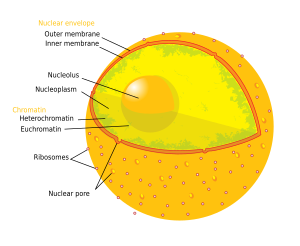Nucleoplasm

The nucleoplasm, also known as karyoplasm,
The soluble, liquid portion of the nucleoplasm is called the karyolymph[3] nucleosol,[4] or nuclear hyaloplasm.
History
The existence of the nucleus, including the nucleoplasm, was first documented as early as 1682 by the Dutch microscopist
Role
Many important cell functions take place in the nucleus, more specifically in the nucleoplasm. The main function of the nucleoplasm is to provide the proper environment for essential processes that take place in the nucleus, serving as the suspension substance for all organelles inside the nucleus, and storing the structures that are used in these processes.
Composition
The nucleoplasm is a highly viscous liquid that is enveloped by the nuclear membrane and consists mainly of water, proteins, dissolved ions, and a variety of other substances including nucleic acids and minerals.
Proteins
Nearly a third of the human protein-coding genes (6784 genes)[2] have been found to localize to the nucleoplasm via targeting by a nuclear localization sequence (NLS). Cytosolic proteins, known as importins, act as receptors for the NLS, escorting the protein to a nuclear pore complex to be transported into the nucleoplasm.[11] Proteins in the nucleoplasm are mainly tasked with participating in and regulating cellular functions that are DNA-dependent, including transcription, RNA splicing, DNA repair, DNA replication, and a variety of metabolic processes.[2] These proteins are divided into histone proteins, a class of proteins that bind to DNA and give chromosomes their shape and regulate gene activity,[12] and non-histone proteins.
The nucleoplasm contains many enzymes that are instrumental in the synthesis of DNA and RNA, including
Ions
The ionic composition of the nucleoplasm is crucial in maintaining
Similarity to cytoplasm
Nucleoplasm is quite similar to the cytoplasm, with the main difference being that nucleoplasm is found inside the nucleus while the cytoplasm is located inside the cell, outside of the nucleus. Their ionic compositions are nearly identical due to the ion pumps and permeability of the nuclear envelope, however, the proteins in these two fluids differ greatly. Proteins in the cytoplasm are termed cytosolic proteins which are produced by free
The cytoplasm and the nucleoplasm are both highly gelatinous structures enclosed by membranous structures- the plasma membrane and the nuclear envelope, respectively. However, while the cytoplasm is contained by a single lipid bilayer membrane, the nuclear envelope that compartmentalizes the nucleoplasm consists of two separate lipid bilayers- an outer membrane and an inner membrane.[20] The cytoplasm is also found in all known cells while nucleoplasm is only found in eukaryotic cells, as
The organelles and other structures within the cytoplasm and nucleoplasm are organized by protein filaments within their respective compartments. The cytoplasm contains the cytoskeleton, a network of protein filaments found in all cells, while the nucleoplasm is believed to contain the nuclear matrix, a hypothetically analogous network of filaments that organizes the organelles and genetic information within the nucleus. While the structure and function of the cytoskeleton have been well documented, the exact function, and even the presence, of the nuclear matrix is disputed.[21] While the exact composition of the nuclear matrix has not been confirmed, type V intermediate filaments, known as nuclear lamins, have been documented in the nucleoplasm, functioning in the structural support of the nucleus as well as the regulation of DNA replication, transcription, and chromatin organization.[22] Cytoplasmic streaming, the circular flow of cytoplasm driven by the cytoskeleton, has been well documented in the cytoplasm, aiding in intracellular transport, but this process has not been documented in the nucleoplasm.
References
- ^ "karyoplasm". Collins English Dictionary. Retrieved 2 December 2022.
- ^ a b c d e f g h "The human cell in nucleoplasm". Human Protein Atlas.
- ^ "karyolymph". Collins English Dictionary. Retrieved 2 December 2022.
- PMID 21886771.
- ISBN 978-0-300-07384-3.
- ^ Brown R (1866). "On the Organs and Mode of Fecundation of Orchidex and Asclepiadea". Miscellaneous Botanical Works I: 511–514.
- ^ "Strasburger, Eduard Adolf". Universalium. 2010. Retrieved October 31, 2022.
- ^ S2CID 17260209.
- ^ PMID 32308628.
- ^ Hed, Greer (October 6, 2022). "What is Nucleoplasm?". wisegeek. Retrieved October 28, 2022.
- ISBN 978-0-12-801394-6.
- S2CID 20285491.
- PMID 20007326.
- PMID 26277545.
- PMID 19618123.
- . Retrieved October 30, 2022.
- PMID 23077175.
- PMID 35180215.
- ^ "The human cell in cytoplasm". Human Protein Atlas.
- ^ "Nuclear Membrane". National Human Genome Research Institute.
- PMID 10712500.
- PMID 20826548.
